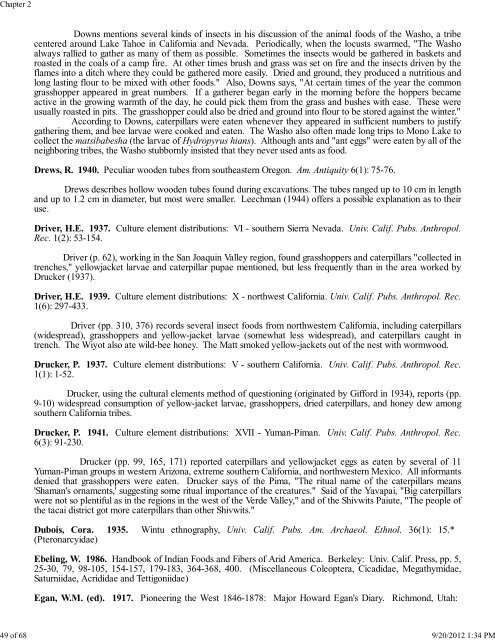Chapter 2. Insect Foods of North American Indigenous Populations ...
Chapter 2. Insect Foods of North American Indigenous Populations ...
Chapter 2. Insect Foods of North American Indigenous Populations ...
Create successful ePaper yourself
Turn your PDF publications into a flip-book with our unique Google optimized e-Paper software.
<strong>Chapter</strong> 249 <strong>of</strong> 68 9/20/2012 1:34 PMDowns mentions several kinds <strong>of</strong> insects in his discussion <strong>of</strong> the animal foods <strong>of</strong> the Washo, a tribecentered around Lake Tahoe in California and Nevada. Periodically, when the locusts swarmed, "The Washoalways rallied to gather as many <strong>of</strong> them as possible. Sometimes the insects would be gathered in baskets androasted in the coals <strong>of</strong> a camp fire. At other times brush and grass was set on fire and the insects driven by theflames into a ditch where they could be gathered more easily. Dried and ground, they produced a nutritious andlong lasting flour to be mixed with other foods." Also, Downs says, "At certain times <strong>of</strong> the year the commongrasshopper appeared in great numbers. If a gatherer began early in the morning before the hoppers becameactive in the growing warmth <strong>of</strong> the day, he could pick them from the grass and bushes with ease. These wereusually roasted in pits. The grasshopper could also be dried and ground into flour to be stored against the winter."According to Downs, caterpillars were eaten whenever they appeared in sufficient numbers to justifygathering them, and bee larvae were cooked and eaten. The Washo also <strong>of</strong>ten made long trips to Mono Lake tocollect the matsibabesha (the larvae <strong>of</strong> Hydropyrus hians). Although ants and "ant eggs" were eaten by all <strong>of</strong> theneighboring tribes, the Washo stubbornly insisted that they never used ants as food.Drews, R. 1940. Peculiar wooden tubes from southeastern Oregon. Am. Antiquity 6(1): 75-76.Drews describes hollow wooden tubes found during excavations. The tubes ranged up to 10 cm in lengthand up to 1.2 cm in diameter, but most were smaller. Leechman (1944) <strong>of</strong>fers a possible explanation as to theiruse.Driver, H.E. 1937. Culture element distributions: VI - southern Sierra Nevada. Univ. Calif. Pubs. Anthropol.Rec. 1(2): 53-154.Driver (p. 62), working in the San Joaquin Valley region, found grasshoppers and caterpillars "collected intrenches," yellowjacket larvae and caterpillar pupae mentioned, but less frequently than in the area worked byDrucker (1937).Driver, H.E. 1939. Culture element distributions: X - northwest California. Univ. Calif. Pubs. Anthropol. Rec.1(6): 297-433.Driver (pp. 310, 376) records several insect foods from northwestern California, including caterpillars(widespread), grasshoppers and yellow-jacket larvae (somewhat less widespread), and caterpillars caught intrench. The Wiyot also ate wild-bee honey. The Matt smoked yellow-jackets out <strong>of</strong> the nest with wormwood.Drucker, P. 1937. Culture element distributions: V - southern California. Univ. Calif. Pubs. Anthropol. Rec.1(1): 1-5<strong>2.</strong>Drucker, using the cultural elements method <strong>of</strong> questioning (originated by Gifford in 1934), reports (pp.9-10) widespread consumption <strong>of</strong> yellow-jacket larvae, grasshoppers, dried caterpillars, and honey dew amongsouthern California tribes.Drucker, P. 1941. Culture element distributions: XVII - Yuman-Piman. Univ. Calif. Pubs. Anthropol. Rec.6(3): 91-230.Drucker (pp. 99, 165, 171) reported caterpillars and yellowjacket eggs as eaten by several <strong>of</strong> 11Yuman-Piman groups in western Arizona, extreme southern California, and northwestern Mexico. All informantsdenied that grasshoppers were eaten. Drucker says <strong>of</strong> the Pima, "The ritual name <strong>of</strong> the caterpillars means'Shaman's ornaments,' suggesting some ritual importance <strong>of</strong> the creatures." Said <strong>of</strong> the Yavapai, "Big caterpillarswere not so plentiful as in the regions in the west <strong>of</strong> the Verde Valley," and <strong>of</strong> the Shivwits Paiute, "The people <strong>of</strong>the tacai district got more caterpillars than other Shivwits."Dubois, Cora. 1935. Wintu ethnography, Univ. Calif. Pubs. Am. Archaeol. Ethnol. 36(1): 15.*(Pteronarcyidae)Ebeling, W. 1986. Handbook <strong>of</strong> Indian <strong>Foods</strong> and Fibers <strong>of</strong> Arid America. Berkeley: Univ. Calif. Press, pp. 5,25-30, 79, 98-105, 154-157, 179-183, 364-368, 400. (Miscellaneous Coleoptera, Cicadidae, Megathymidae,Saturniidae, Acrididae and Tettigoniidae)Egan, W.M. (ed). 1917. Pioneering the West 1846-1878: Major Howard Egan's Diary. Richmond, Utah:
















